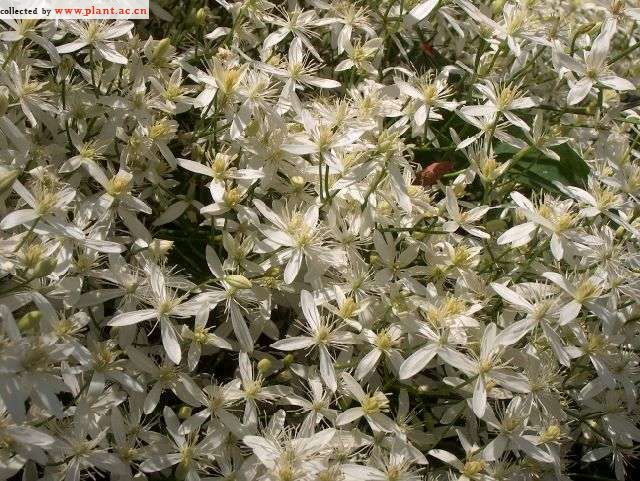Clematis ternifloraSweet autumn clematis
科:毛茛科
Family:Ranunculaceae
属:铁线莲属
common name:Sweet autumn clematis
introduce:Plant Type: Vine
Family: Ranunculaceae
Missouri Native: No
Native Range: Japan, North America
Height: 15 to 30 feet
Spread: 15 to 30 feet
Bloom Time: August - September
Bloom Color: Creamy white
Sun: Full sun to part shade
Water: Medium moisture
Maintenance: High
General Culture:
Easily grown in average, medium wet, well-drained soil in full sun to part shade. Unlike almost all other species of clematis, this plant will thrive and bloom well in considerable shade. Blooms on new growth. Prune hard in fall after flowering or in early spring.
Noteworthy Characteristics:
Sweet autumn clematis, as the common name suggests, is a fragrant fall-bloomer. It is a vigorous, deciduous, twining vine with an extremely rampant growth habit. If given support, it will climb rapidly with the aid of tendrilous leaf petioles to 20-25 in length. Without support, it will sprawl along the ground as a dense, tangled ground cover (to 6-12" tall and 10 wide) which typically chokes out most weeds. Features aromatic, 1" diameter, cruciform, pure white flowers (each with 4 narrow petal-like sepals) in terminal panicles from late August to October in a profuse bloom which typically covers the foliage. Flowers give way to attractive, plume-like seed heads. Compound, leathery-textured, shiny green leaves (3-5 oval to elliptic leaflets with cordate bases). Sweet autumn clematis can invasively self-seed in the landscape, and has escaped cultivation and naturalized in many parts of the U.S., particularly in the East and Midwest. Synonymous with and sometimes sold as C. maximowicziana, C. paniculata and C. dioscoreifolia, although technically C. paniculata is a separate species native to New Zealand.
Problems:
No serious insect or disease problems. Invasive, sometimes hard-to-control vine.
Uses:
Trellises, arbors, posts, fences. Can also be allowed to sprawl along the ground as a dense ground cover to hide old tree stumps or other eyesores. Can also be grown through large shrubs, but growth must be monitored to insure that the shrub is not overwhelmed.
